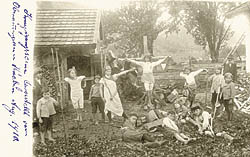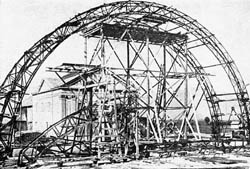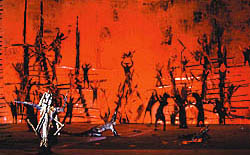A Play of Life and Death,
promised in a moment of mortal threat so began the history of the Oberammergau Passion Play in 1633.  In the middle of the Thirty Years War (1618-1648), after months of suffering and death from the plague, the inhabitants of Oberammergau swore an oath that they would perform the “Play of the Suffering, Death and Resurrection of Our Lord Jesus Christ every ten years. At Pentecost 1634, they fulfilled their pledge for the first time on a stage they put up in the cemetery above the fresh graves of the plague victims. In the year 2010, the Community of Oberammergau will for the 41th time be performing the play they have preserved throughout the centuries with singular continuity often against resistance.
In the middle of the Thirty Years War (1618-1648), after months of suffering and death from the plague, the inhabitants of Oberammergau swore an oath that they would perform the “Play of the Suffering, Death and Resurrection of Our Lord Jesus Christ every ten years. At Pentecost 1634, they fulfilled their pledge for the first time on a stage they put up in the cemetery above the fresh graves of the plague victims. In the year 2010, the Community of Oberammergau will for the 41th time be performing the play they have preserved throughout the centuries with singular continuity often against resistance.

Passion plays performed throughout Europe in the Middle Ages, then banned from the cities in the 16th century were, after experiencing a heyday in Baroque-Catholic Southern Germany, forbidden there as well in the middle of the 18th century in the wake of the age of enlightenment. Oberammergau alone kept the tradition alive. Was it a sense of obligation to the pledge? Or was it the theological support of the nearby Ettal and Rottenbuch Monasteries that made the difference? In any event, the people succeeded in acquiring a privilege from the
lord elector and thus rescued the fascinating undertaking of depicting the Passion of Jesus on the stage into the 19th century.
A Man of “Flesh and Blood”
Today, the churches appreciate the possibility of telling of Jesus as a man “of flesh and blood” in a way that helps all mankind to relate to him, as is the case in the play. To this day, elements from the various stages of development throughout the play’s 350-year history still cling to the text (Othmar Weis/Joseph A. Daisenberger), the stage and the music (Rochus Dedler). However, the Oberammergau Passion Play is particularly characterized by the musically illustrated tableaux vivants inserted into the story. These comparisons with moments in Israel’s history of faith are intended to guide the spectator toward a sympathetic understanding of what Jesus wants, things for which he has provoked resistance and which occur below the surface of the drama of this seemingly pointless failure. While, on the one hand Oberammergau looks to its tradition when accomplishing the task of telling “The Greatest Story ever Told”, nevertheless each generation will find it impossible to tell it any other way than in the horizon of its own history of life and faith. Living, authentic drama has nothing to do with cliches and calls for a personal approach to the subject matter.
Oberammergau Passion Play 1984
The Passion Play Today
In this spirit, during a work period of several years, the text and music were fundamentally revised, new settings and costumes designed and a new production created in countless rehearsals. Now, more than 2,000 Oberammergauers, actors, singers, instrumentalists and stage technicians, in approximately six hours of playing time bring to the stage those events Christianity regards as its central source of life and hope.
Otto Huber (Assistant Director and Literary Advisor)


